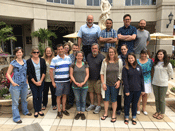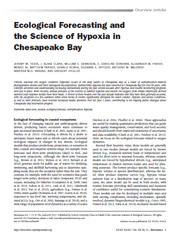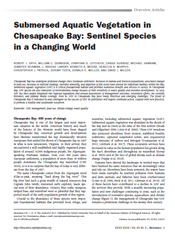Ecological drought in the United States - synthesis workshop
 A recent workshop in June 2017 represented the culmination of almost two years of work by Simon Costanzo, Brianne Walsh, and Bill Dennison with the United States Geological Survey, summarizing the status of ecological drought science across the United States. This synthesis workshop was hosted by the National Socio-Environmental Synthesis Center (SESYNC) in Annapolis, Maryland, with representatives from eight Climate Science Centers which are part of the U.S. Department of the Interior, and where IAN had conducted workshops at each beginning in 2015. The objectives of this final workshop were to 1) synthesize our findings from those eight individual workshops into a synthesis newsletter, 2) develop a synthesis paper for publication, and 3) generate a paper outlining emerging trends in the ecological drought in the United States.
A recent workshop in June 2017 represented the culmination of almost two years of work by Simon Costanzo, Brianne Walsh, and Bill Dennison with the United States Geological Survey, summarizing the status of ecological drought science across the United States. This synthesis workshop was hosted by the National Socio-Environmental Synthesis Center (SESYNC) in Annapolis, Maryland, with representatives from eight Climate Science Centers which are part of the U.S. Department of the Interior, and where IAN had conducted workshops at each beginning in 2015. The objectives of this final workshop were to 1) synthesize our findings from those eight individual workshops into a synthesis newsletter, 2) develop a synthesis paper for publication, and 3) generate a paper outlining emerging trends in the ecological drought in the United States.
Ecoforecasting paper published in Bioscience
 "Ecological forecasting and the science of hypoxia in Chesapeake Bay" was published in Bioscience in June. Twelve graduate students, faculty and staff contributed to this effort, led by Jeremy Testa of Chesapeake Biological Laboratory. The paper is an outcome of a graduate course in the Marine Estuarine Environmental Sciences program. The paper analyzes the results of ten years of annual ecological forecasts for the size of the summertime oxygen deficient waters (also known as "dead zones"). The increasing scientific and public attention to these hypoxia events makes this a timely paper.
"Ecological forecasting and the science of hypoxia in Chesapeake Bay" was published in Bioscience in June. Twelve graduate students, faculty and staff contributed to this effort, led by Jeremy Testa of Chesapeake Biological Laboratory. The paper is an outcome of a graduate course in the Marine Estuarine Environmental Sciences program. The paper analyzes the results of ten years of annual ecological forecasts for the size of the summertime oxygen deficient waters (also known as "dead zones"). The increasing scientific and public attention to these hypoxia events makes this a timely paper.
Submerged aquatic vegetation synthesis published in Bioscience
 "Submerged aquatic vegetation in Chesapeake Bay: Sentinel species in a changing world" was published in Bioscience in June. Thirteen scientists from a diversity of institutions have been collaborating in a synthesis effort (SAV SYN), sponsored by the Chesapeake Bay Program. Bob Orth and Bill Dennison co-led the effort. The paper focuses on the ability of submerged aquatic vegetation (SAV) to be a guardian or protector of the health of Chesapeake Bay acting as a sentinel species. The paper also discusses the idea that SAV can be sensitive indicator of environmental change. Chesapeake Bay SAV are facing both historical and emerging challenges, with both positive and negative stories about its future persistence.
"Submerged aquatic vegetation in Chesapeake Bay: Sentinel species in a changing world" was published in Bioscience in June. Thirteen scientists from a diversity of institutions have been collaborating in a synthesis effort (SAV SYN), sponsored by the Chesapeake Bay Program. Bob Orth and Bill Dennison co-led the effort. The paper focuses on the ability of submerged aquatic vegetation (SAV) to be a guardian or protector of the health of Chesapeake Bay acting as a sentinel species. The paper also discusses the idea that SAV can be sensitive indicator of environmental change. Chesapeake Bay SAV are facing both historical and emerging challenges, with both positive and negative stories about its future persistence.
Setting the course for sustainability with Ecosystem Health Report Cards course
 IAN will be teaching a course on developing ecosystem health report cards this fall. The course is intended for environmental managers and practitioners outside of academia. Participants will learn the complete process of report card generation, including stakeholder mapping and engagement, conceptualization of ecosystem function, selection of indicators and benchmarks, data analysis, communication of results, and leveraging the report card to make real change. This course will employ a "flipped" or "inverted" classroom, in which lectures will be provided before class time via short YouTube videos. Students will learn how to be a discussion facilitator, rapporteur, and synthesis writer to insure the class time sessions are productive. Course details and registration info coming soon!
IAN will be teaching a course on developing ecosystem health report cards this fall. The course is intended for environmental managers and practitioners outside of academia. Participants will learn the complete process of report card generation, including stakeholder mapping and engagement, conceptualization of ecosystem function, selection of indicators and benchmarks, data analysis, communication of results, and leveraging the report card to make real change. This course will employ a "flipped" or "inverted" classroom, in which lectures will be provided before class time via short YouTube videos. Students will learn how to be a discussion facilitator, rapporteur, and synthesis writer to insure the class time sessions are productive. Course details and registration info coming soon!

